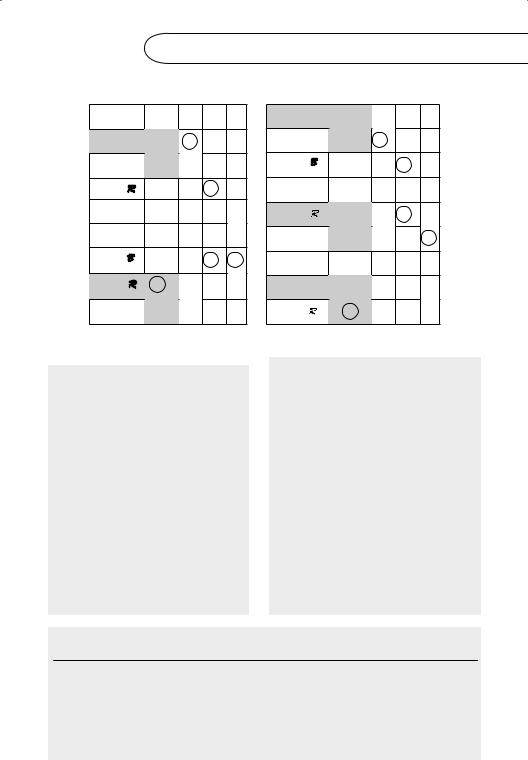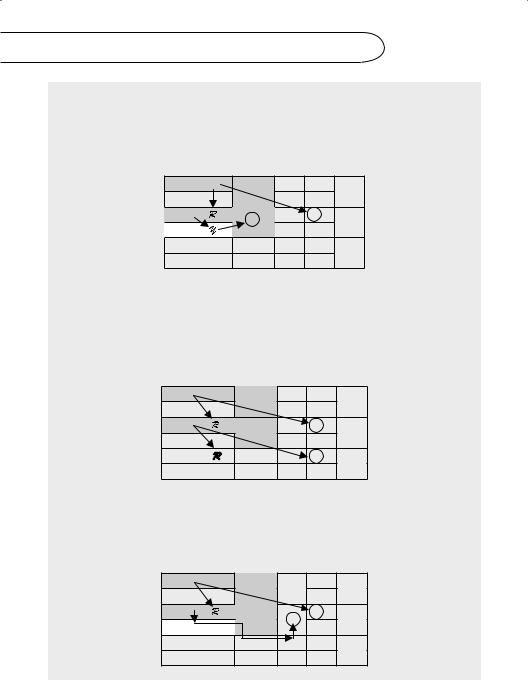
- •Contents
- •Series Preface
- •Acknowledgments
- •RATIONALES UNDERLYING NEPSY AND NEPSY-II
- •NEPSY DEVELOPMENT
- •NEPSY-II REVISION: GOALS AND DEVELOPMENT
- •COMPREHENSIVE REFERENCES
- •CONCLUDING REMARKS
- •APPROPRIATE TESTING CONDITIONS
- •TYPES OF ASSESSMENTS
- •ASSESSING CHILDREN WITH SPECIAL NEEDS
- •OTHER ADMINISTRATION CONSIDERATIONS
- •SUBTEST-BY-SUBTEST RULES OF ADMINISTRATION
- •COMPUTER SCORING
- •PREPARATORY TO SCORING
- •ORDER OF SCORING
- •STEP-BY-STEP SCORING
- •TESTS WITH COMPLEX RECORDING AND/OR SCORING
- •QUICK-SCORING: DESIGN COPY GENERAL (DCG)
- •DESIGN COPYING PROCESS (DCP) SCORING
- •OVERVIEW OF SUBTEST SCORES
- •SUMMARIZING NEPSY-II SCORES
- •CONCLUDING REMARKS
- •GOALS OF INTERPRETATION AND IMPLEMENTATION OF GOALS
- •STEP-BY-STEP INTERPRETATION OF NEPSY-II PERFORMANCE
- •INTRODUCTION
- •TEST DEVELOPMENT
- •STANDARDIZATION
- •PSYCHOMETRIC PROPERTIES
- •ADMINISTRATION AND SCORING
- •INTERPRETATION
- •OVERVIEW OF STRENGTHS AND WEAKNESSES
- •THE NEPSY-II REFERRAL BATTERIES
- •DEVELOPMENTAL DISORDERS AND NEPSY-II
- •EVIDENCE OF RELIABILITY IN NEPSY-II
- •CONVENTIONS FOR REPORTING RESULTS
- •RELIABILITY PROCEDURES IN NEPSY-II
- •CONCLUDING REMARKS
- •CASE STUDY #1: GENERAL REFERRAL BATTERY
- •CLINICAL IMPRESSIONS AND SUMMARY
- •PRELIMINARY DIAGNOSIS
- •RECOMMENDATIONS
- •DIAGNOSIS
- •Appendix: NEPSY-II Data Worksheet
- •References
- •Annotated Bibliography
- •About the Authors
- •Index

136 ESSENTIALS OF NEPSY-II ASSESSMENT
Some subtests have combined scores only, some have contrast scores only, and some subtests have both combined and contrast scores.
Step 5: Behavioral Observations
Behavioral Observations are scored by tallying Behavioral Observations or checking presence or absence as required. For example, every time the child was inattentive/off-task during the Auditory Attention and Response Set subtest, you recorded a tally mark in the Behavioral Observation Box at the bottom of the page. Those marks are now counted up and the total raw score written in the appropriate bubble on the Behavioral Observation page inside the front cover of the Record Form. After you have recorded totals or presence/absence by checking “yes/no” boxes for all pertinent Behavioral Observations, this qualitative data can be converted to quantitative information by looking up cumulative percentages in Table D.1 or D.4 and the percent in the standardization population in Table D.2 or D.5 in the NEPSY-II Clinical and Administrative Manual. An example of a quantified Behavioral Observation would be the frequency with which motor overflow (that is, involuntary movements that accompany, and are similar to, a required motor response) is observed in a child of a particular age. Some motor behaviors are observed more often in younger children than in older children in the normative group, as is indicated in the norms.
TESTS WITH COMPLEX RECORDING AND/OR SCORING
Subtests with Complex Recording and/or Scoring will be addressed individually in this chapter. They include:
•Auditory Attention
•Clocks
•Design Copying
•Inhibition
•Memory for Designs
•Visuomotor Precision
Auditory Attention and Response Set Subtest
The Auditory Attention and Response Set (AA/RS) subtest is made up of two sections, Auditory Attention (AA) and Response Set (RS). Recording and scoring this test may seem complex at first, but with practice, recording and scoring will fall into place. Note that while you record the child’s performance you need to keep following the child’s performance. This demands divided attention and a certain level of training. Score as outlined in subsequent steps.

HOW TO SCORE THE NEPSY-II 137
Auditory Attention and Response Set Subtest
The Auditory Attention and Response Set (AA/RS) subtest is made up of two sections, Auditory Attention (AA) and Response Set (RS). Recording and scoring this test may seem complex at first, but with practice, recording and scoring will fall into place. Note that while you record the child’s performance you need to keep following the child’s performance. This demands divided attention and a certain level of training. Score as outlined in subsequent steps.
Step 1: Total Correct Scores and Percentile Ranks
Total Correct Scores are Primary Scores on the AA/RS Tests. In the Auditory Attention (AA) section, look for all of the Rs that occurred within the two shaded spaces (2 sec.) for each target word RED. Circle 1 if you have written R next to the target word or the word that follows it in the shaded area. When added, the numbers you have circled will be the AA Total Correct score that you will enter in the appropriate box at the bottom of the AA Record Form page. Use this to find the AA Total Correct Scaled Score and Percentile Rank in Table A.1 and enter in the correct box at the bottom of the page.
The RS Total Correct score is derived in the same manner. If the target word is YELLOW, to which the child is to respond Red, and you have written R next to it or next to the word in the space immediately following the target word, circle 1. If the target word is RED, and the child correctly points at the yellow circle, a Y should be written next to the word RED on the Record Form or in the space immediately following. For the word BLUE, the child should simply point at the blue circle. If the child responds correctly a B should be written beside the target word or in the space immediately following. For any of these correct responses within the 2-second window, the 1 should be circled. When added, the numeral ones that you have circled will be the RS Total Correct raw score that you will enter in the appropriate box and will use to find the RS Total Correct Scaled Score and Percentile Rank in Table A.1. Enter these values in the correct box at the bottom of the page on the RS Record Form. Figure 3.3 illustrates recording correct scores.
Step 2: Error Scores
In order to derive the AA and RS error scores, which are Process Scores, one must understand the types of errors and how to record them. This process was discussed in Chapter 2 in the individual subtest instructions for the Auditory Attention and Response Tests, but will be repeated here to give continuity to the scoring process (Figure 3.4 illustrates the recording and scoring of errors on the AA/RS subtest.)

138 ESSENTIALS OF NEPSY-II ASSESSMENT
Correct Responses
Auditory Attention
listen |
|
c |
|
RED |
1 |
o c |
|
square |
c |
||
|
|||
now |
|
c |
|
yellow |
|
c i |
but |
|
|
c |
|
blue |
|
|
c |
i |
RED |
1 |
o |
c |
|
there |
|
c |
|
|
|
|
|
Response Set
BLUE |
1 |
|
c |
|
|
but |
o |
c |
|
||
|
|
||||
take |
|
|
c |
|
|
that |
|
|
c |
|
|
RED |
1 |
|
c |
|
|
square |
o |
c |
i |
||
|
|||||
put |
|
|
c |
|
|
YELLOW |
1 |
|
c |
i |
|
empty |
|
c |
|||
|
|
Figure. 3.3 Scoring and Recording on AA/RS
•Omission Error: Circle o in the Error column, if the child does not respond at all within the 2-sec. interval.
•Commission Errors: Circle c in the Error column for any of the following:
■Any response not within 2 sec. of the target word (shaded area).
■Incorrect response within the 2 sec. interval. This is also an Inhibitory Error.
■Touching the white page in response to hearing white.
■If child responds correctly two times within the 2 sec. interval, the second response is a commission error.
•Inhibitory Errors: Circle i in Error columns in the following cases:
■On AA, an Inhibitory Error occurs when any color other than red is touched within the 2 sec. interval. Caution: This is also a Commission Error.
■On RS, the child responds to a color word by touching that color within the 2 sec. interval when it is not a correct response. (For example, on RS, the child touches yellow when he or she hears yellow, but he or she should inhibit and touch red instead.)
•Commission Errors (c) in Overlapping Sets: If the R response is outside the shaded area for the second RED, or if it is another color within or without the shaded area, a “c” is circled. If it is another color within the shaded area, it is also an Inhibitory Error, so the “i” is also circled.
•Omission Errors (o) in Overlapping Sets: If there is no response to the second RED, circle “o” to designate an Omission Error. See Caution box concerning recording and scoring errors in overlapping sets on the AA/RS Test.
The Process Scores for AA and RS that are derived from the errors marked on the Record Form include AA Total Commission Errors, AA Total Omission Errors, and AA Total Inhibitory Errors, as well as RS Total Commission Errors, RS Total Omission Errors, and RS Total Inhibitory Errors. Total all of the Commission Errors

HOW TO SCORE THE NEPSY-II 139
Auditory Attention
listen |
|
|
c |
|
RED |
1 |
o |
c |
|
square |
|
|
c |
|
now |
|
|
c |
|
yellow |
|
|
c |
i |
but |
|
|
c |
|
blue |
|
|
c |
i |
RED |
1 |
o |
c |
|
there |
|
|
c |
|
Response Set
BLUE |
|
|
c |
|
but |
1 |
o |
c |
|
take |
|
|
c |
|
that |
|
|
c |
|
RED |
|
|
c |
|
square |
1 |
o |
c |
i |
put |
|
|
c |
|
YELLOW |
|
|
c |
|
empty |
1 |
|
c |
i |
Figure. 3.4 Omission, Commission and Inhibitory Errors on AARS
Omission Error– No correct response within 2-sec. window of target word Red.
Two Commission Errors –
First R response is outside of 2-sec. window and B response is to an incorrect color. (Respond only to target word Red on Auditory Attention.)
Inhibitory Error – Child did not inhibit response to Blue, when should only respond to Red.
One Correct Response –
Touched red circle within 2-sec. window of target “Red.”
Omission Error– No correct response within 2-sec. window of target word Blue.
Two Commission Errors – Response to Blue outside 2-sec. window and touched red circle when heard “Red,” but should not have. (In Response Set, touch red circle when you hear Yellow and touch yellow when hear Red.)
Inhibitory Error – Child did not inhibit touch to the red circle and switch to a yellow response , when heard Red.
One Correct Response – Heard
Yellow, touched red.
C A U T I O N
Evaluating Overlapping Sets
If two targets have overlapping shaded areas, evaluate from the top of
that sequence to score the fi rst response. On Response Set, if the response to the fi rst target word YELLOW falls in the shaded space next to the second
(continued )

140 ESSENTIALS OF NEPSY-II ASSESSMENT
(continued )
target word RED, assume that the R response you have recorded is the child’s response to the fi rst target word YELLOW and not to the second, RED.
Therefore, it is a Commission Error. If you have recorded a Y next to the red or in the next space by the word square, it would be scored as the child’s response to the RED and would, therefore, receive 1 point.
YELLOW |
1 |
c |
|
|
go |
|
c |
i |
|
RED |
1 |
c |
|
|
square |
c |
i |
||
|
||||
black |
|
c |
|
|
thing |
|
c |
i |
Commission Errors (c) in Overlapping Sets:
In Auditory Attention, if the fi rst R response is outside the shaded area for the fi rst RED, or if it is another color within or without the shaded area, a “c” is circled. If it is another color within the shaded area, it is also an Inhibitory Error, so the “i” is also circled. The second response to the second RED is also outside the shaded area for the second target word, so it is a commission error, as well.
RED |
1 |
c |
|
go |
|
c |
i |
RED |
1 |
c |
|
square |
|
c |
i |
black |
|
c |
|
thing |
|
c |
i |
Omission Errors (o) in Overlapping Sets:
In the above Auditory Attention example, if there is no response to the second RED, circle “o” to designate an Omission Error. Remember that the R beside the second RED is the response to the fi rst Red.
RED |
1 |
|
c |
|
go |
|
o |
c |
i |
RED |
1 |
o |
c |
|
square |
|
c |
i |
|
|
|
|||
black |
|
|
c |
|
thing |
|
|
c |
i |
(marked “c”), all of the Omission Errors (“o”), and all of the Inhibitory Errors (“i”), and enter the totals for each type of error in the appropriate box on the bottom of the Record Form. The percentile ranks for these raw scores are looked up in Table A.1, and then entered in the appropriate boxes on the bottom of the Record Forms.

HOW TO SCORE THE NEPSY-II 141
Step 3: Combined Scores
The Combined Scores are Primary Scores on the AA/RS Test. The AA Combined Score integrates the AA Total Correct Scaled Score and the AA Total Commission Errors Percentile Rank for ages 5–12 (Table B.2) and the AA Total Correct Percentile Rank and the AA Total Commission Errors Percentile Rank for ages 13–16 (Table B.3). Caution: These AA Combined Scores are derived in two different ways. For ages 5–12, the AA Total Correct Score is integrated with the Total Commission Errors Percentile Rank. For ages 13–16, the two percentile ranks (Total Correct SS Percentile Rank and Total Commission Errors Percentile Rank) are integrated. See Caution box. The RS Combined Scores are derived in the same way, integrating the RS Total Correct Scaled Score and the RS Total Commission Errors Percentile Rank for ages 7–12 (Table B.4) and the RS Total Correct Percentile Rank and the RS Total Commission Errors Percentile Rank for ages 13–16 (Table B.5). Note that there is pale shading on the Record Form for both AA and RS that guides you in deriving the AA Combined Score and the RS Combined Scores.
Step 4: Contrast Score
The AA vs. RS Contrast Scaled Score compares the child’s performance on AA (AA Combined Scaled Score) with the child’s performance on RS (RS Combined Scaled Score). When you have completed both tests, the AA Combined Score and the RS Combined Score are entered into the appropriate boxes shaded in a pale color at the bottom of the RS Record Form page. Using these scores, the Contrast Score is then looked up in Table C.1 as indicated in white on the colored
C A U T I O N
Deriving AA and RS Combined Scores
AACombined Scores are derived in two different ways:
•For ages 5–12, the AA Total Correct Score is integrated with the Total Commission Errors Percentile Rank.
•For ages 13–16, the two percentile ranks (Total Correct SS Percentile Rank and Total Commission Errors Percentile Rank) are integrated.
The RS Combined Scores are derived in the same way:
•For ages 7–12, the RS Total Correct Scaled Score and the RS Total Commission Errors Percentile Rank are integrated. (Table B.4)
•For ages 13–16, the RS Total Correct Percentile Rank and the RS Total Commission Errors Percentile Rank are integrated.

142 ESSENTIALS OF NEPSY-II ASSESSMENT
arrow that points to the AA vs. RS Contrast Scaled Score box at the bottom of the RS page of the Record Form. The value resulting from this table is entered into the final appropriate box.
This contrast allows one to compare the child’s performance on a simple selective auditory attention task (AA) to performance on a complex auditory attention task (RS), during which one must sustain selective attention on one target, while using executive functions to shift set between two other targets.
Step 5: Behavioral Observations
After all quantitative scores have been looked up and recorded, one should tally the frequency of designated AA/RS Behavioral Observations: Inattentive/Distracted Off-task Behaviors during AA and during RS separately and Out of Seat/Physical Movement in Seat Off-Task Behaviors during AA and during RS separately. Enter each of these totals in the appropriate bubble on the left side of the Record Form at the bottom of each page. These raw score totals are then transferred to the Behavioral Observation summary page on the inside front cover of the Record Form. For ages 5–6, Table D.1 is used to obtain Cumulative Percentages for these raw scores, and for ages 7–16 Table D.4 is used. Enter the Cumulative Percentages in the appropriate rectangular box under Auditory Attention and Response Set. Scoring is complete at this point.
Clocks Subtest
The Clocks (CL) subtest, along with the Design Copying Test that follows it in this chapter, both require clinical judgment in scoring. Therefore, it is important to be familiar with the scoring criteria before you begin administering and scoring these tests.
Step 1: Score the Criteria for Items 1–4 and Items 9–10 and Sum the Item Scores
On pp. 127–133 of Appendix A in the Administration Manual are found the Scoring Procedures for the Clock Subtest. The criteria are illustrated with examples of children’s performances. Study these carefully and keep them present as you score.
On Drawing to Command Items 1 and 2, as well as Clock Copy Items 9 and 10, a child’s Clock subtest performance is evaluated according to the criteria for:
•Numbers
■Presence
■Location
■Sequence

HOW TO SCORE THE NEPSY-II 143
See the Caution box on the following page: Scoring the Numbers–Sequence
Criteria on Clocks. |
|
|||
• |
Contour |
|
||
|
■ |
Presence |
C A U T I O N |
|
|
■ |
Accommodation |
||
|
|
|||
|
■ |
Closure |
Scoring the |
|
|
■ |
Symmetry |
||
|
Numbers–Sequence |
|||
• Hands |
||||
Criteria on Clocks |
||||
|
|
Presence |
||
|
■ |
|
||
|
■ |
Connection |
To score the Numbers-Sequences |
|
|
■ |
Proportion |
criteria for items 1–4 and 9–10, the |
|
|
■ |
Correct Target |
manner in which the child draws the |
|
|
numbers on the clock face must be |
|||
• |
Center |
|||
noted during testing. |
||||
|
|
|
||
■Presence
■Location
After these criteria have been evaluated for each of these four items (Items l–2; 9–10) and scored 0 or 1, add the scores across the row from left to right for each item and place the sum of the scores in the shaded item scoring box on the far right hand side of the page under Item Score.
On the Digital–Analog task, Items 3 and 4, the child’s performance is only scored for the criteria for:
•Hands
■Presence
■Connection
■Proportion
■Correct Target
•Center
■Presence
■Location
Again, after the items have been carefully evaluated for the aforementioned criteria and scored 0 or 1, add the scores across the appropriate row and place the sum in the shaded box at the end of the row.
Step 2: Score Correct/Incorrect on Items 5–8
On the Clock Reading without Numbers and the Clock Reading with Numbers tasks (Items 5–8), the child’s answer is either correct or incorrect, so the score for each of these items is circled as 1 or 0.

144 ESSENTIALS OF NEPSY-II ASSESSMENT
Step 3: Derive the CL Total Score (Raw Score) and CL Scaled Score
Sum the Item Scores in the far right-hand column of the Clocks Record Form, including those in shaded boxes and the Item 5–8 scores of 0 or 1. Place the resulting total in the CL Total Score box. The colored arrow shows you that Table A.1 should be used to obtain the CL Scaled Score.
Design Copying Subtest
The Design Copying (DC) subtest has two scoring methods:
•The quick scoring method provides the DC General score. This method is a quick and simple way of scoring.
•DC Process scoring system provides more diagnostic information as it assesses three skills associated with paper/pencil copying:
■Motor—the ability to use fine motor control in manipulating a pencil.
■Global—the ability to reproduce the general gestalt of a design.
■Local—the ability to reproduce details, shapes, and sizes of a design, as well as the correct relationship between design elements.
DON’T FORGET
Interpretation of Regulatory Factors on DCP
Spatial, detail, or fi ne motor processing impairments are scored.
Planning and execution are not scored, but your interpretation should always take into account whether or not errors are due to
•Regulatory factors (e.g., executive functioning). Executive functions needed for accurate design copying include:
■ Employing ordering and sequencing necessary to see that the design will fi t in the allotted space and fi gure-ground errors are not made.
Be sure that you digest the Scoring Procedures for both types of scoring for the Design Copying Test on pp. 135–182 in the Administration Manual. Also become familiar with the use of the Scoring Template that came with your NEP- SY-II kit. At first, you should score each item in a child’s DC subtest while referring to this guide. There you will find General Scoring Considerations as
